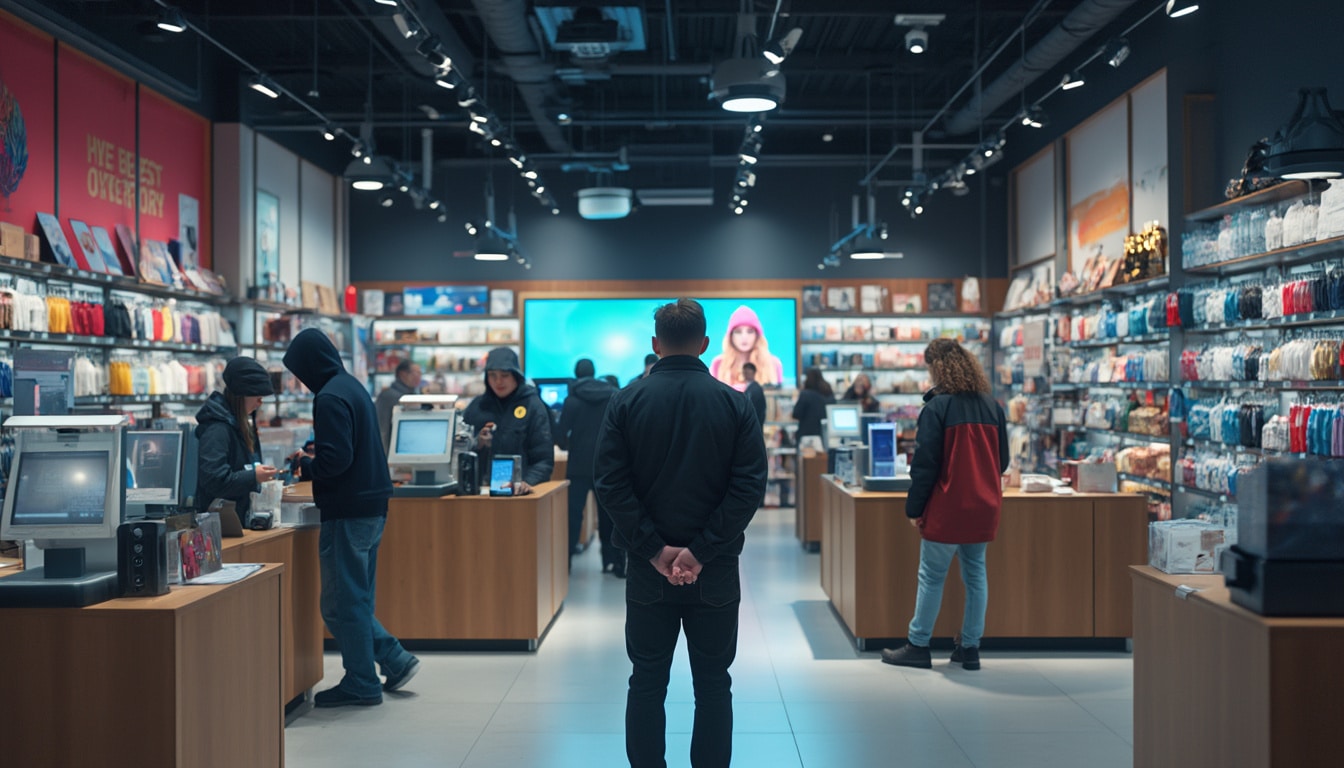Ever walked into a store where you can browse freely without a sales assistant in sight? Welcome to the world of modern retail innovations! It’s a shopper’s paradise, or so it seems.
These advancements have undeniably boosted store profitability, but they’ve also unintentionally opened the door for an increase in shoplifting. It’s fascinating to observe the adaptability of those who find ways to bypass systems, turning every new feature into an opportunity for mischief.
The dilemma for large retailers is balancing customer temptation with security measures. The more enticing the shopping experience, the higher the sales, yet this also raises the risk of theft. This issue isn’t new; shoplifting has been a persistent challenge since the inception of the first stores.
In the realm of management research, such thefts are categorized alongside other losses like breakages and inventory errors, referred to as managing « leaks. » Every major commercial innovation—from open entrances in 19th-century department stores to early 20th-century self-service models—has seen a corresponding rise in theft incidents.
The introduction of free entry in department stores revolutionized shopping by allowing customers to enter freely and browse without a specific purchase in mind. This shift transformed shopping into a more leisurely activity, particularly attracting middle-class women who became the primary clientele.
This newfound freedom created an almost dreamlike environment where customers could touch, feel, and try products without immediate obligation to buy. Such an atmosphere amplifies the temptation to purchase—and sometimes to steal—when the excitement outweighs restraint.
Moving forward, the advent of self-service in grocery stores further streamlined operations and reduced costs. However, allowing customers to handle products directly also made it easier for theft to occur. The self-service model peaked in popularity with the introduction of automatic checkouts, which, while efficient, have become hotspots for opportunistic theft.
Automatic checkouts not only cut down on labor costs but also inadvertently make it easier for thieves to skim items without detection. Innovations like artificial intelligence are now being employed to monitor suspicious behavior, but these solutions often face legal challenges related to privacy regulations.
Despite these challenges, retail innovations continue to evolve, driven by the need to enhance profitability and improve the customer experience. History shows that each wave of innovation brings its own set of challenges, particularly concerning shoplifting. Yet, the persistence of these models underscores their effectiveness in the competitive retail landscape.
Table of contents
Togglehow store innovations can paradoxically lead to an increase in thefts
Innovations in retail have revolutionized the shopping experience, enhancing efficiency and profitability. However, these advancements often come with an unexpected downside: a rise in thefts. From open entry systems to self-service models and automated checkouts, each new innovation brings its own set of challenges for retailers striving to balance customer convenience with security.
what role does store layout play in theft prevention?
The evolution of store layouts has significantly impacted both sales and security. Traditional stores required customers to approach a counter and interact directly with sales staff, inherently limiting opportunities for theft. However, the introduction of large department stores with open entry and self-service aisles transformed the shopping paradigm.
Free entry models empower customers to browse freely without immediate supervision, fostering a more relaxed shopping environment. While this approach increases sales by encouraging prolonged browsing, it also inadvertently provides more opportunities for theft. The absence of physical barriers means that items are more accessible, making it easier for potential thieves to conceal merchandise.
For instance, the advent of the grand magasin in the late 19th century allowed customers unparalleled freedom to explore multiple departments under one roof. This shift not only boosted sales by creating a more engaging shopping experience but also laid the groundwork for increased shoplifting incidents. As shoppers had more items within reach, the temptation to steal grew alongside the opportunity.
how does self-service shopping influence theft rates?
Self-service has become a cornerstone of modern retail, particularly in the food sector. Initially introduced in the United States during the 1930s, self-service allowed customers to select their own items, dramatically reducing wait times and lowering labor costs. This model proved highly effective in increasing turnover and sales volume.
However, the self-service approach also opened new avenues for theft. With multiple items within easy access, it becomes more challenging for store personnel to monitor each interaction closely. The rise of self-scanning checkout systems further exemplifies this trend. While automated checkouts streamline the payment process, they also reduce the oversight that traditional cashier models provide, making it easier for individuals to exploit vulnerabilities.
In the UK, for example, the introduction of self-service in the 1950s saw a significant uptick in shoplifting. The number of theft-related arrests doubled within a decade, highlighting the direct correlation between self-service models and increased theft rates. Stores must therefore navigate the delicate balance between operational efficiency and effective theft prevention.
what impact do automated checkouts have on shoplifting?
Automated checkout systems, or self-scanning technologies, represent the latest innovation in retail. These systems offer customers the convenience of scanning and paying for items without waiting in line, thus enhancing the overall shopping experience. According to Nielsen, over 57% of grocery stores have adopted some form of self-checkout, underscoring its widespread acceptance.
While beneficial for reducing wait times and lowering staffing costs, automated checkouts also present significant security challenges. Without dedicated cashiers, these systems rely heavily on customer honesty, which can lead to an increase in unintentional or deliberate theft. Studies indicate that voluntary theft, such as forgetting to scan an item, accounts for approximately 1% of total store revenue loss.
Moreover, sophisticated theft techniques have emerged alongside technological advancements. Fraudsters employ methods like masking barcodes, purchasing multiple identical items, and manipulating item quantities to bypass detection. An Australian supermarket observed a peculiar case dubbed « carrot fraud, » where customers would replace expensive vegetables like avocados with cheaper carrots during the scanning process, leading to substantial revenue loss.
To combat these challenges, retailers are increasingly turning to artificial intelligence (AI) solutions. AI-driven surveillance systems can monitor for suspicious behaviors, identify failed scans, and detect the use of counterfeit barcodes. For example, Intermarché has integrated AI-based monitoring in some of its stores, significantly reducing incidents of theft without necessitating price increases. However, the implementation of AI is not without its hurdles, particularly concerning data privacy regulations like the European GDPR.
For more insights on how AI is transforming security measures, you can explore AI can craft a replica of your personality; researchers sound the alarm.
why do theft rates spike with each new retail innovation?
Historical trends reveal a consistent pattern: every major retail innovation tends to be accompanied by a rise in theft rates. Whether it was the introduction of department stores, self-service models, or automated checkouts, each advancement has provided new opportunities for theft, demonstrating the adaptability of shoplifters.
The psychological aspect plays a crucial role in this paradox. Innovations often heighten the allure of shopping, creating an environment where the temptation to steal is magnified. As stores become more inviting and the shopping experience more enjoyable, the line between purchasing and taking becomes increasingly blurred for some individuals.
Paul Dubuisson, a psychiatrist from the early 20th century, observed that large department stores provided an environment where traditional moral restraints were diminished, especially among women. This observation remains relevant today, as the modern shopping experience continues to challenge conventional notions of security and morality.
Moreover, the integration of new technologies like self-service and automated checkouts inherently involves reducing human oversight, which can inadvertently facilitate theft. As stores strive to enhance customer convenience and operational efficiency, they must also develop innovative security measures to counteract the increased opportunities for theft.
how can retailers balance innovation with security?
Balancing the benefits of retail innovation with effective security measures is a complex challenge. Retailers must employ a multifaceted approach that leverages technology, staff training, and strategic store layouts to mitigate the risk of theft while maintaining an appealing shopping environment.
Artificial Intelligence offers promising solutions for enhancing security without compromising customer experience. AI-driven systems can provide real-time monitoring and analysis of shopping behaviors, enabling stores to identify and address suspicious activities promptly. Implementing AI can significantly reduce the incidence of theft by detecting anomalies that human staff might overlook.
Additionally, integrating AI with existing security infrastructure can enhance overall store safety. For example, surveillance cameras equipped with AI can analyze footage for specific patterns indicative of shoplifting, such as repeated product selections or unusual scanning behaviors. This proactive approach allows for immediate intervention before theft occurs.
Employee training is another critical component of an effective security strategy. Staff members must be educated on the latest theft prevention techniques and encouraged to maintain a visible presence within the store. Regular training sessions can equip employees with the skills needed to identify and respond to potential theft scenarios effectively.
Furthermore, store layout plays a pivotal role in theft prevention. Designing aisles and display arrangements to minimize blind spots and ensure clear lines of sight can deter potential thieves. Strategic placement of high-value items in well-monitored areas reduces the likelihood of opportunistic theft.
For those interested in understanding how digital threats like phishing can compromise retail security, refer to How can you outsmart phishing attacks and protect your digital life?.
what are the economic implications of increased theft in retail?
The economic impact of theft on the retail sector is substantial, affecting both profitability and operational costs. Retailers must account for losses due to shoplifting, employee theft, and administrative errors, collectively known as fuites or « losses. » These losses not only reduce profit margins but also necessitate increased investments in security measures, which can further strain financial resources.
The direct costs associated with theft include the value of stolen merchandise and the expenses related to recovery efforts, such as security systems and personnel training. Indirect costs, on the other hand, encompass the broader implications of reduced customer trust and potential damage to a store’s reputation. Frequent instances of theft can deter shoppers, leading to decreased foot traffic and lower overall sales.
Moreover, the financial burden of theft can lead to cost-cutting measures in other areas, such as reducing staff or limiting store amenities, which in turn can negatively impact customer experience and employee morale. This cyclical effect highlights the pervasive nature of theft-related challenges within the retail industry.
In extreme cases, significant theft losses can threaten the viability of retail businesses, particularly small and medium-sized enterprises that may lack the financial resilience to absorb substantial losses. Consequently, addressing theft is not only a matter of protecting assets but also ensuring the long-term sustainability of retail operations.
For more dramatic examples of theft and its consequences, read about Paris: a handbag containing nuclear secrets stolen.
how do global innovation rankings influence retail security strategies?
Global innovation rankings, like those highlighting Switzerland’s position at the top, reflect a country’s commitment to technological advancement and economic development. These rankings can significantly influence retail security strategies by setting benchmarks for adopting cutting-edge technologies and best practices.
Countries that rank highly in global innovation indexes tend to foster environments where technological advancements are rapidly integrated into various sectors, including retail. This proactive approach encourages retailers to adopt innovative security solutions, such as AI-driven surveillance systems and automated theft detection mechanisms, to stay competitive and protect their assets effectively.
Switzerland’s rise to the top of global innovation rankings exemplifies how a supportive ecosystem can drive the adoption of advanced technologies in retail. Swiss retailers benefit from a robust infrastructure, access to research and development resources, and a culture that embraces innovation, enabling them to implement sophisticated security measures that mitigate theft risks effectively.
Moreover, being part of a highly innovative economy can provide retailers with access to the latest security technologies and expertise, enhancing their ability to respond to evolving theft tactics. This dynamic is crucial in an era where theft techniques are becoming increasingly sophisticated, requiring constant adaptation and innovation in security strategies.
For insights into how global innovation trends impact various industries, explore how Switzerland rises to the top of global innovation rankings.
what future trends may influence theft prevention in retail?
As retail continues to evolve, several emerging trends are poised to shape the future of theft prevention. The integration of advanced technologies, changing consumer behaviors, and heightened regulatory standards are key factors that will influence how retailers address theft in the coming years.
Artificial Intelligence and Machine Learning will play increasingly significant roles in theft prevention. These technologies enable more precise and proactive monitoring of shopping behaviors, allowing for real-time detection and response to suspicious activities. AI can analyze vast amounts of data to identify patterns indicative of potential theft, facilitating more effective intervention strategies.
Another trend is the growing emphasis on data security and privacy. With the rise of automated systems and digital transactions, safeguarding customer and store data has become paramount. Retailers must navigate the complexities of data protection regulations, such as the GDPR, to implement security measures that respect privacy while maintaining robust theft prevention mechanisms.
The proliferation of smart technologies, such as Internet of Things (IoT) devices, also presents new opportunities and challenges for theft prevention. Smart shelves, RFID tags, and connected cameras can enhance inventory management and security surveillance, providing more accurate tracking of merchandise and easier identification of discrepancies.
Additionally, the shift towards omnichannel retailing, where physical and online shopping experiences are seamlessly integrated, requires a comprehensive approach to theft prevention. Retailers must implement cohesive security strategies that span both digital and physical storefronts, ensuring consistent protection across all sales channels.
Finally, the increasing collaboration between retailers and technology providers is essential for developing innovative security solutions. Partnerships with cybersecurity firms, AI developers, and security experts can enable retailers to stay ahead of emerging threats and continuously enhance their theft prevention capabilities.
For a broader perspective on how AI is impacting various sectors, including retail security, check out Federal authorities connect $150 million cyber heist to LastPass hacks of 2022.
how can retailers leverage AI without compromising customer experience?
Integrating Artificial Intelligence into retail security offers significant benefits, but it must be done thoughtfully to avoid negatively impacting the customer experience. Retailers must strike a balance between enhancing security and maintaining a welcoming, enjoyable shopping environment.
One approach is to implement AI-driven systems discreetly, ensuring that security measures do not intrude upon the shopping experience. For example, AI-powered cameras can monitor for suspicious behaviors without being overtly visible or disruptive. This allows for effective theft prevention while preserving the store’s aesthetic and customer-friendly atmosphere.
Another strategy is to use AI to enhance customer service rather than solely focusing on security. AI can be employed to personalize the shopping experience, offering recommendations and assistance while simultaneously monitoring for potential theft activities. By integrating security functions with customer-centric applications, retailers can provide a seamless experience that prioritizes both safety and satisfaction.
Transparency is also crucial in maintaining customer trust when deploying AI-based security measures. Retailers should communicate openly with customers about the use of AI technologies, emphasizing their role in safeguarding both merchandise and customer data. Clear communication can alleviate concerns about privacy and foster a sense of security among shoppers.
Furthermore, retailers should ensure that AI systems are trained to minimize false positives and prevent unnecessary interventions. Overzealous security measures can lead to customer frustration and damage the store’s reputation. By fine-tuning AI algorithms to accurately detect genuine threats, retailers can enhance security without compromising the overall shopping experience.
Finally, continuous monitoring and evaluation of AI systems are essential for maintaining their effectiveness and customer-friendliness. Retailers must regularly assess the performance of their AI-driven security measures, making adjustments as needed to address evolving theft tactics and customer expectations.
For a deeper understanding of how AI duplicates personalities and the potential risks involved, read AI can craft a replica of your personality; researchers sound the alarm.
what are the ethical considerations in using AI for theft prevention?
The deployment of Artificial Intelligence in retail security raises several ethical considerations that retailers must address to ensure responsible and fair use of technology. These considerations encompass privacy, bias, transparency, and accountability.
Privacy is a primary concern when implementing AI-based surveillance systems. Retailers must collect and process customer data in compliance with data protection regulations, such as the GDPR in Europe. Ensuring that customer information is securely stored and used solely for legitimate security purposes is essential for maintaining trust and avoiding legal repercussions.
Bias in AI algorithms is another ethical issue that retailers must confront. If AI systems are trained on biased data, they may disproportionately target specific groups of customers, leading to discriminatory practices. Retailers must ensure that their AI models are trained on diverse and representative datasets to minimize bias and promote fairness in security measures.
Transparency in AI operations is crucial for ethical implementation. Retailers should openly disclose the use of AI technologies in their security strategies, providing clear explanations of how these systems work and the purposes they serve. Transparency helps build customer trust and allows individuals to make informed decisions about their interactions with AI-enabled environments.
Accountability is also vital when utilizing AI for theft prevention. Retailers must establish clear protocols for addressing errors or misuse of AI systems, ensuring that there are mechanisms in place to rectify situations where customers are wrongly accused of theft. Holding AI systems accountable involves regular audits, performance reviews, and adherence to ethical standards in technology deployment.
Moreover, the ethical use of AI in retail security extends to the broader societal impact. Retailers should consider how their AI practices align with principles of autonomy, consent, and respect for individual rights. Striving for ethical AI implementation not only safeguards customers but also enhances the retailer’s reputation and long-term sustainability.
By addressing these ethical considerations, retailers can harness the power of AI to prevent theft effectively while upholding the values of fairness, privacy, and respect for their customers.














